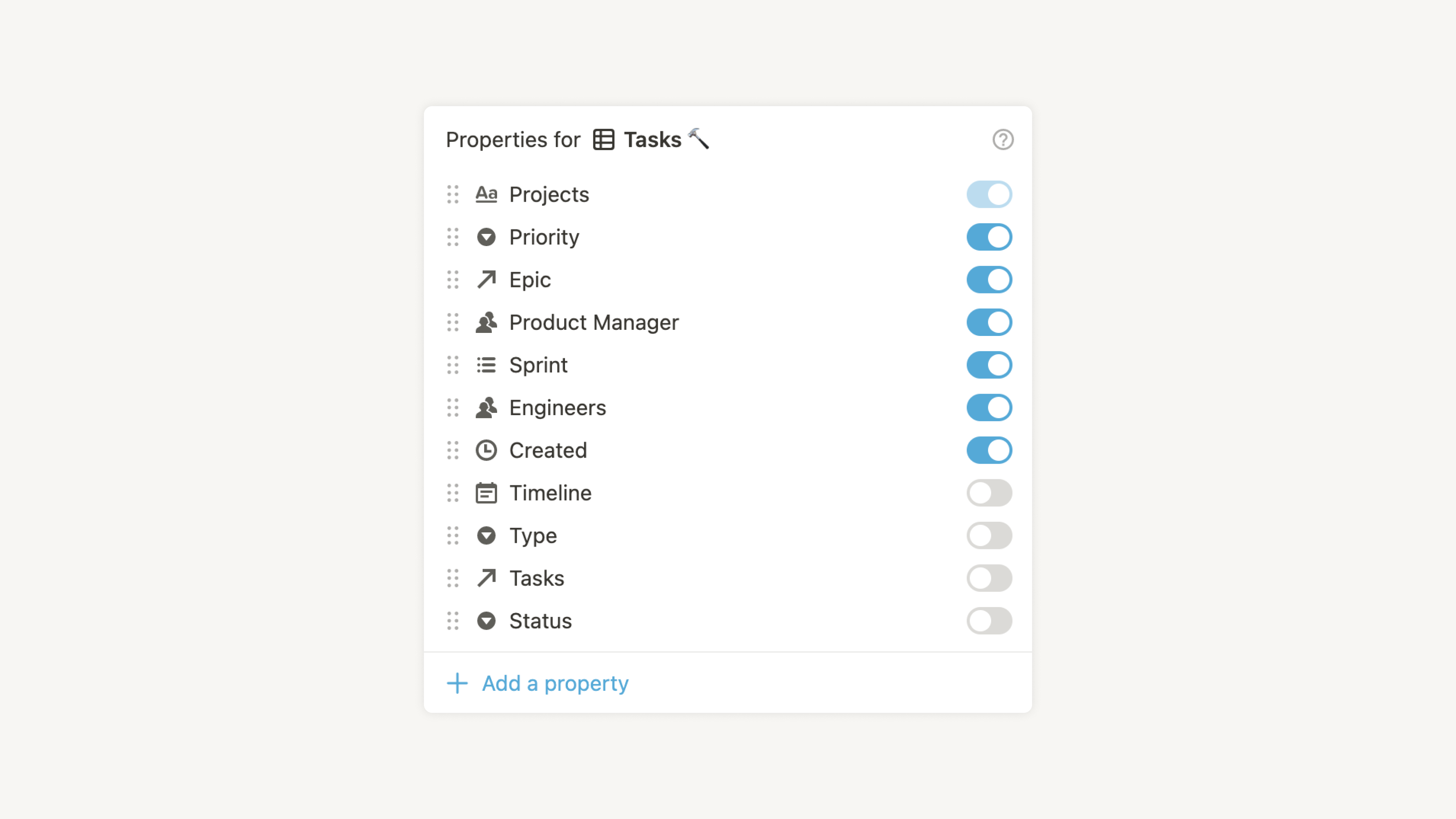Intro to databases

Databases in Notion are collections of pages. Here, we'll introduce you to the general structure of a database, walk you through the different menus and options, and deep dive into how to open and edit pages within a database. 🗃
There are three things that distinguish Notion databases from spreadsheets and databases you can build with other software:
Every item is its own page: Every item you enter into your database is a Notion page. Open a database item to add more information in the form of text, images, and more, as you would with any other Notion page!
Customizable properties: Add properties to contextualize, label, and augment any database item with things like dates, status, and links. Learn more about database properties here →
Multiple layouts you can toggle between: Your data isn't stuck in a table. View the exact same database as a board, list, calendar, gallery, or timeline — whatever makes the information most useful. Learn more about views, filters, and sorts here →
Every full-page database has the same menus and sets of options. Here's a quick walkthrough.
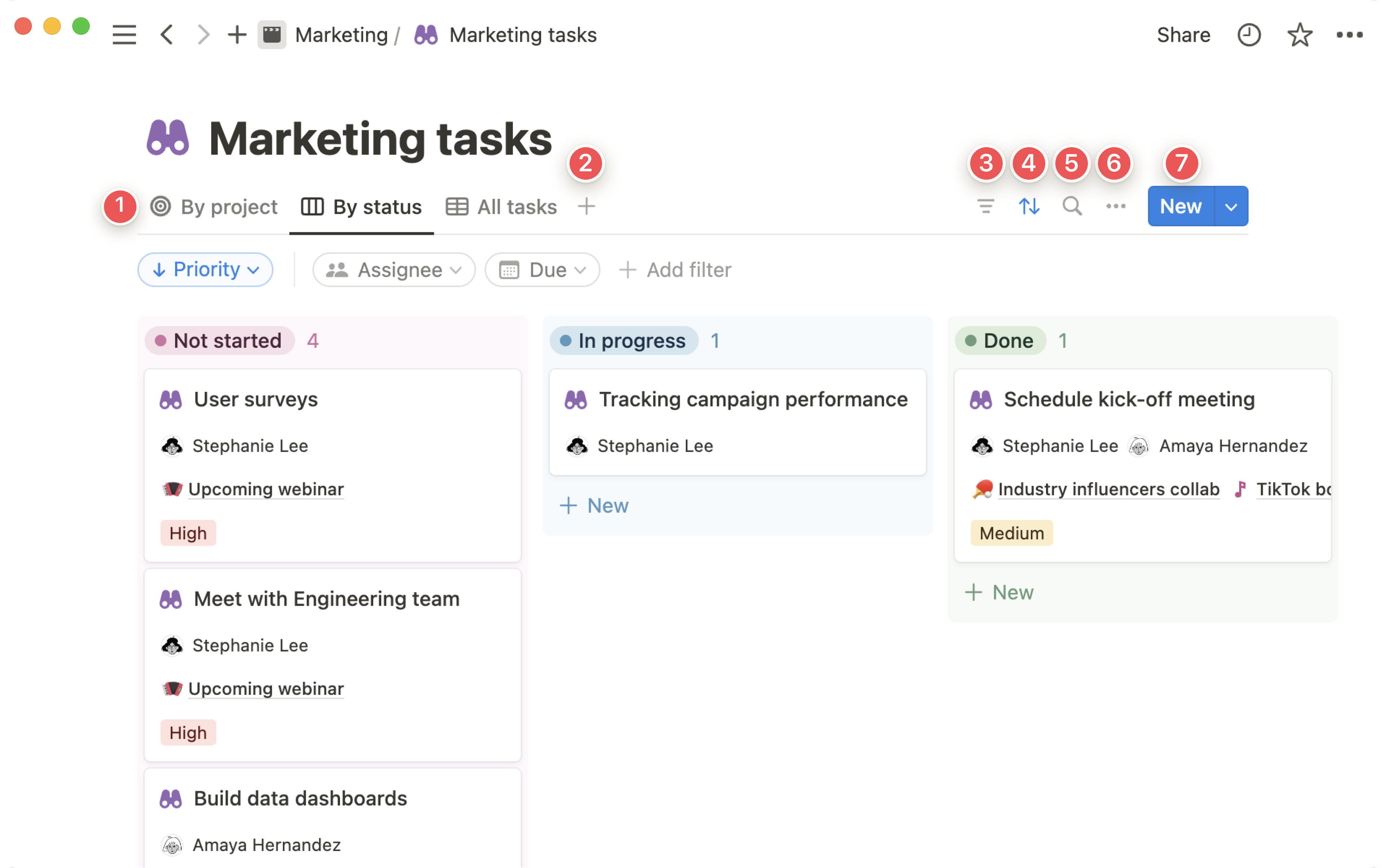
Views: Edit and switch between all the different views of your database. Depending on your screen size, you may have to open the dropdown next to your current view to see your other views.
Add a new view: Add a new view to your database, with its own layout, filters and sorts. Depending on your screen size, you may have to open the dropdown next to your current view and select
Add view.Filter menu: Apply filters based on property values. When you apply a filter to a database, only you can see it to start, but you can save them to the view for your entire shared team if you prefer!
Sort menu: Sort your data by a property. Like filters, sorts are only visible to you by default, but you can make them visible to your whole team as well.
Database search: Type in any word, whether it's in the name of a database item or in a property, and your database will only show items that fit that search query.
••• menu: Located at the top right of your database, this allows you to edit your view layout, grouping, properties, and more.
Create a new database page: Click this to add a new page to your database. Depending on your screen size, this may appear as
+orNew. Open the dropdown next to this button to access and edit any database templates you've configured.

There are several ways to create a database inside Notion:
Create a new page in your workspace, then build a table, board, list, timeline, calendar, or gallery in it.
Create a database page inside an existing page by typing
/followed by the database layout you want (table, board, etc.).
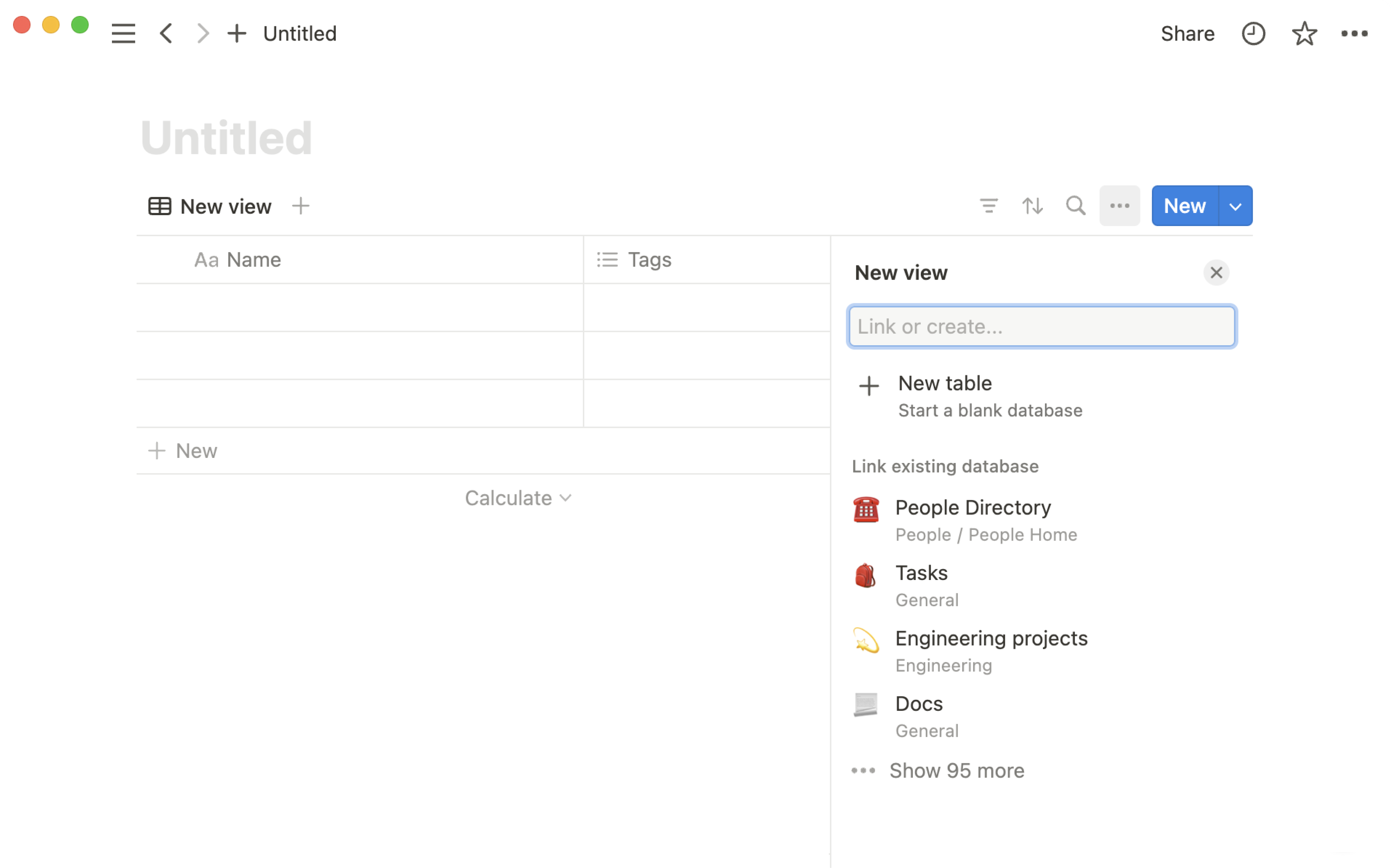
When you create a database, you can start from scratch or pull in data from another part of your workspace.
If you want to use the same properties or an existing view of a database, we suggest selecting an existing data source. Search for an existing database and then choose the one you'd like to use.
If the information you're adding to the database doesn’t exist anywhere else in your workspace, we suggest creating a new data source.
Full page vs. in-line databases

Full-page databases
Full-page databases appear just like any other page in your sidebar.
You can lock a full-page database so that other people can't change properties and value options by selecting
•••at the top of your database →Lock database.To turn a full-page database into an inline database, drag the database into another page in the sidebar, which will turn it into a subpage. Then navigate into the page, and select
⋮⋮→Turn into inline.
Inline databases
Controls and menus for your inline database are hidden until you hover over it.
You can expand an inline database to a full-page database by selecting
⤡at the top.You can turn an inline database into a full-page database by clicking
⋮⋮and dragging it into the sidebar as a top-level page.You can
Delete,Duplicate, move, or copy the link to your inline database by selecting⋮⋮, which will appear on hover to the side.In your sidebar, your inline database will appear as a subpage of the page it's in.
You can make a copy of a database.
For inline databases:
Hover over the database, then select
⋮⋮.Select
Duplicate. You can choose toDuplicate with contentor, if you want to use the same database setup to organize other pages,Duplicate without content.
For full pages:
Click the
•••button in the top right.Select
Duplicate. You can choose toDuplicate with contentor, if you want to use the same database setup to organize other pages,Duplicate without content.
Every item in your database, whether it's a row in a table or a card on a board or calendar, is its own Notion page that you can build, format and nest content in like any other page.
To add database items:
For all databases: Click the blue
Newbutton at the top right.For a
table,listorboard: Click+ Newat the bottom to add a new item.For a
calendar: Click the+icon that appears when you hover over any day. This creates a new event on that day.For a
gallery: Click the+ Newbutton in the empty card at the bottom of your gallery to add a new image frame right there.
To open database items as pages:
In
tables, hover over your first column and click theOPENbutton that appears.In
lists, just click on the title of the item.In
boards,calendars, andgalleries, click anywhere on the card.Pages will always open in a peek preview. Click
⤡at the top left to view in full-page mode.
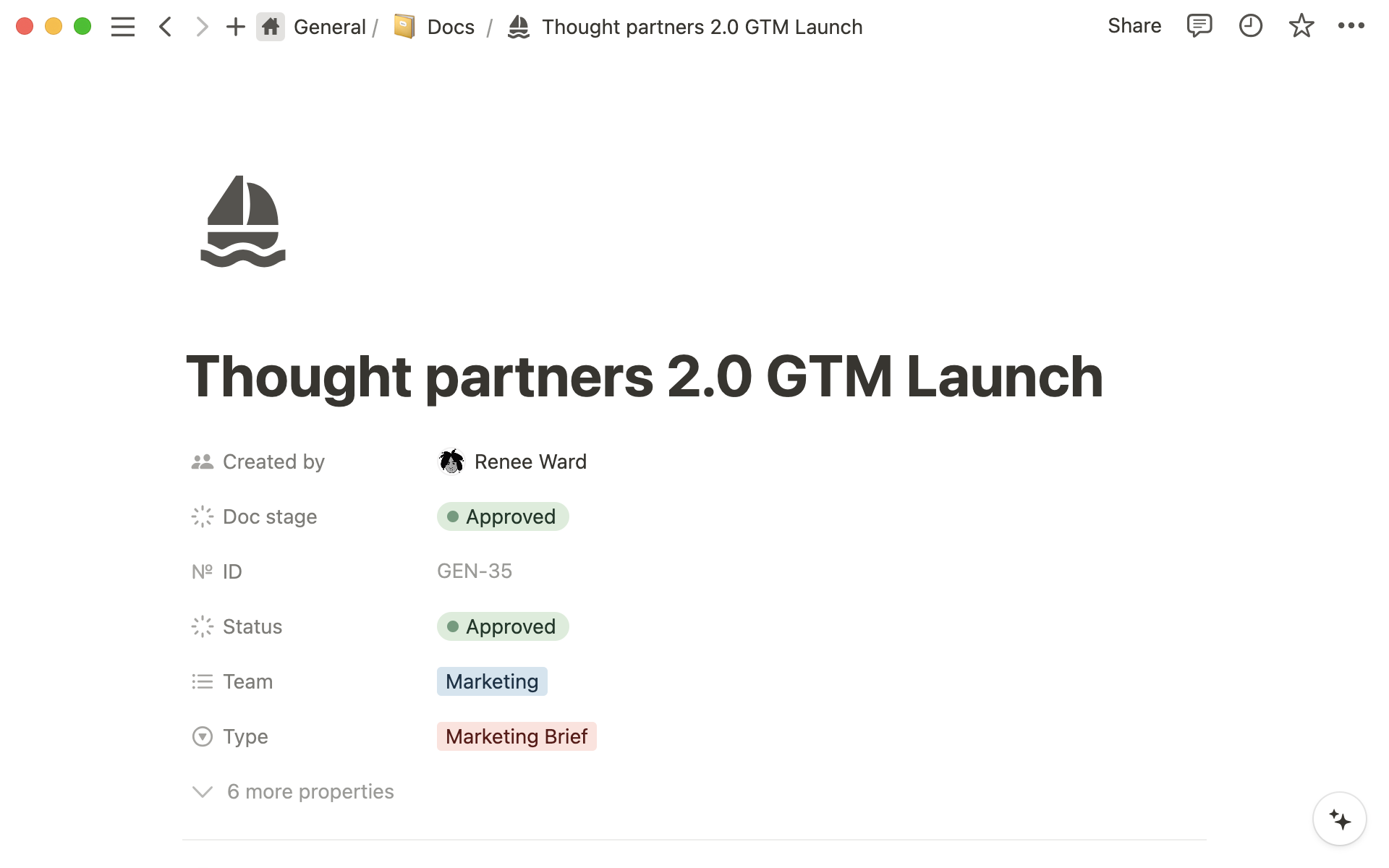
In this page, you'll see all your database properties at the top. Each row is one property, with a name, type, and a value. Click on the value to edit.
Click the
⋮⋮that appears to the left of each property on hover in order to: drag it up or down, change theProperty type, rename it,DuplicateorDeleteit.
Underneath your properties is free page space, where you can add any type of content block, including sub-pages or an in-line database.
Because database items are pages, any other type of content you drag into a database (like bullets or to-do items), will automatically turn into pages.
Item options
Right click on an item to reveal a list of actions. Those actions include:
Delete: Deletes the item from your database.Duplicate: Creates an exact copy of the item.Copy link: Copies an anchor link to that specific item to your clipboard.Rename: Lets you rename the page in your row without opening it.Move to: Lets you move the row to another workspace or page (where it will show up as a subpage).Edit property: Brings up a menu with all your table's properties. Click the one you want and then click the new value for it.
Customize database pages
The top section of any page in a Notion database can include several things:
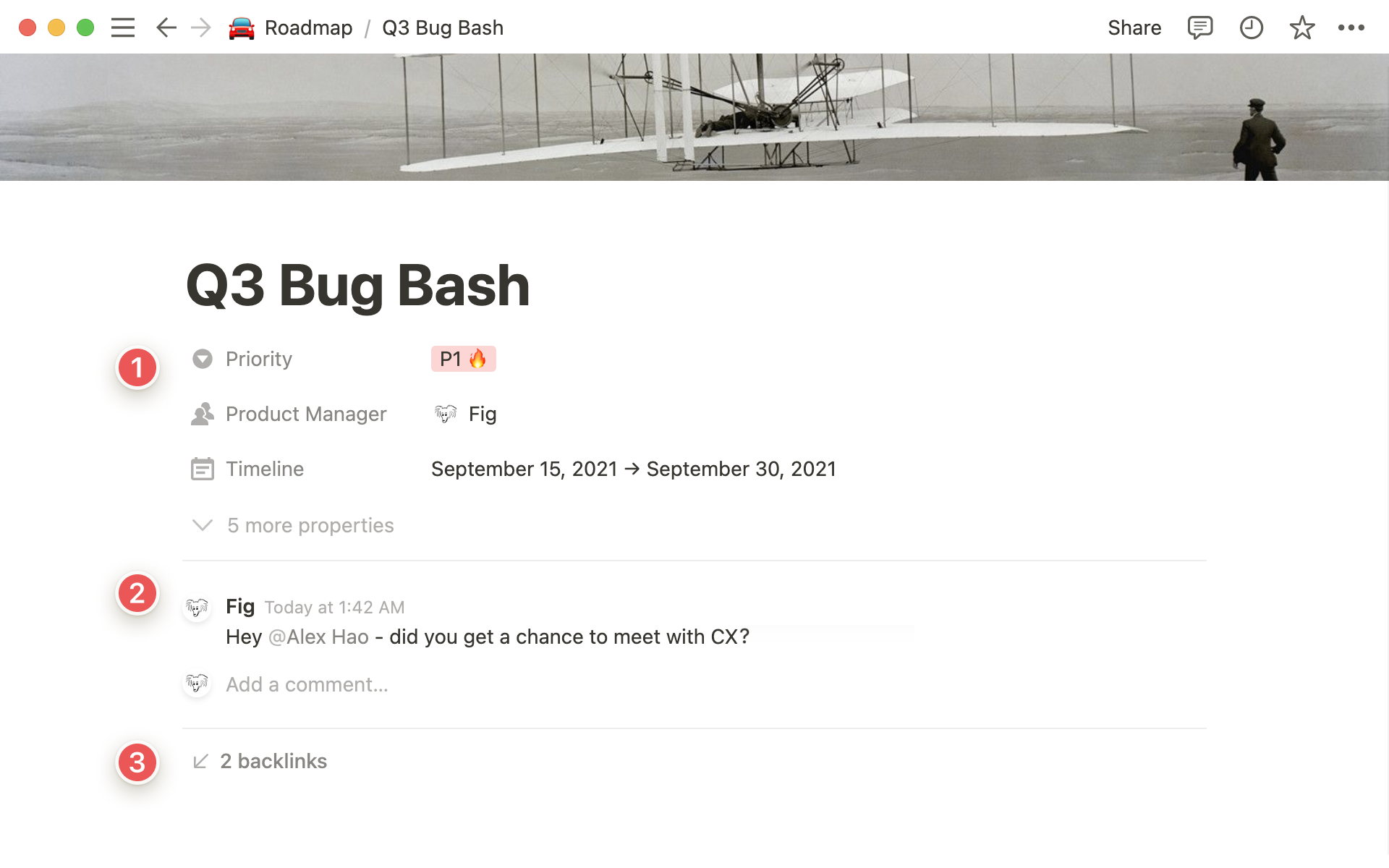
Properties provide data about the page you're looking at, like project owner, due date, tags, and more.
Comments capture conversation between you and your teammates. You can use them to tag each other, ask questions, provide feedback and more.
Backlinks indicate all the pages that link to the current page so you can easily navigate between them.
As with everything in Notion, you can customize the look and feel of these components. To access these options:
Click the
•••at the top right of any Notion page in a database and selectCustomize page.
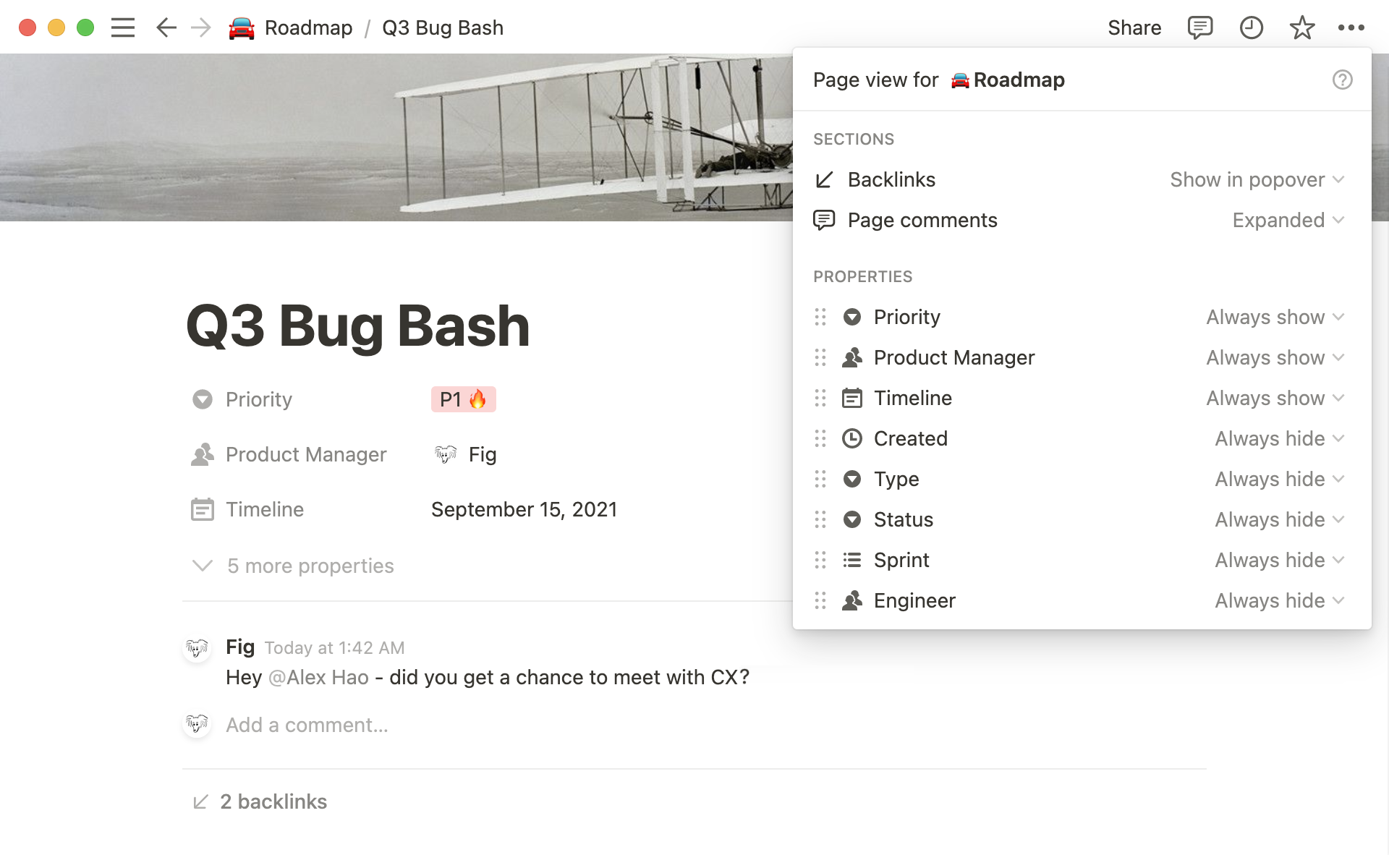
For properties, you can use this menu to choose which property fields you want to show at the top of the page, and how. For each one, select from:
Always show: Nothing changes, you continue to see the property field.
Hide when empty: The property field will disappear from the top of your page if it has no value in it.
Always hide: The property field will not show up at the top of your page.
You can also access the Customize page menu by clicking the ⋮⋮ icon next to any property in the list at the top of your database page. This ⋮⋮ icon can also be clicked and dragged up or down to reorder how properties are displayed on your page.
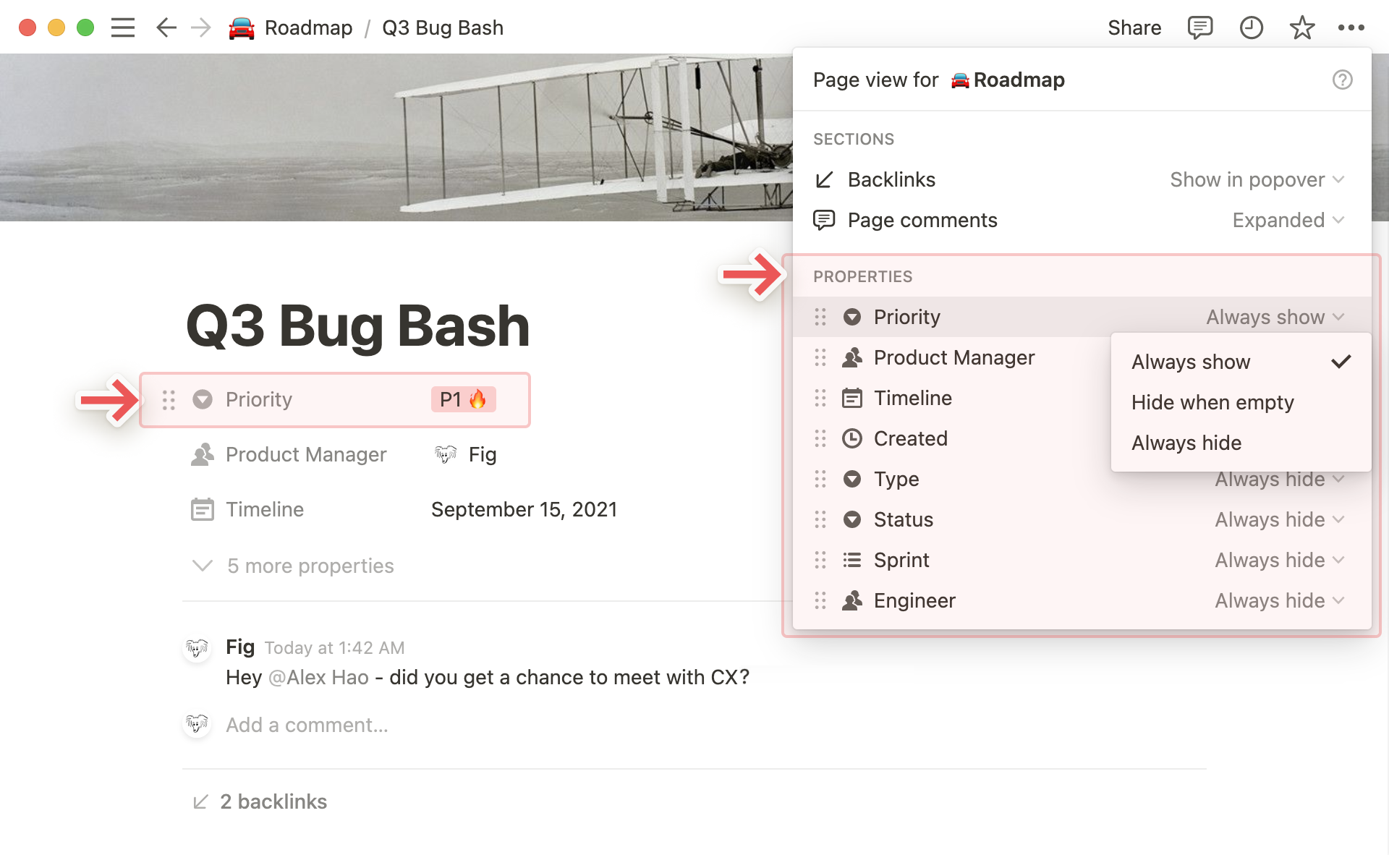
Tip: If you have a database with dozens of properties, hiding some properties is a great way to keep your pages clear.
Note: When you hide properties, they get aggregated in a single menu item at the bottom of the list. You can click this to easily show any hidden properties.
For backlinks, you can choose:
Expanded: See all the pages that link to the current page listed in full.
Show in popover: In case you don't want to see all the pages, you can choose to see just the number of backlinks. Click to open a popup displaying all the pages.
Off: Just hide all backlinks entirely.
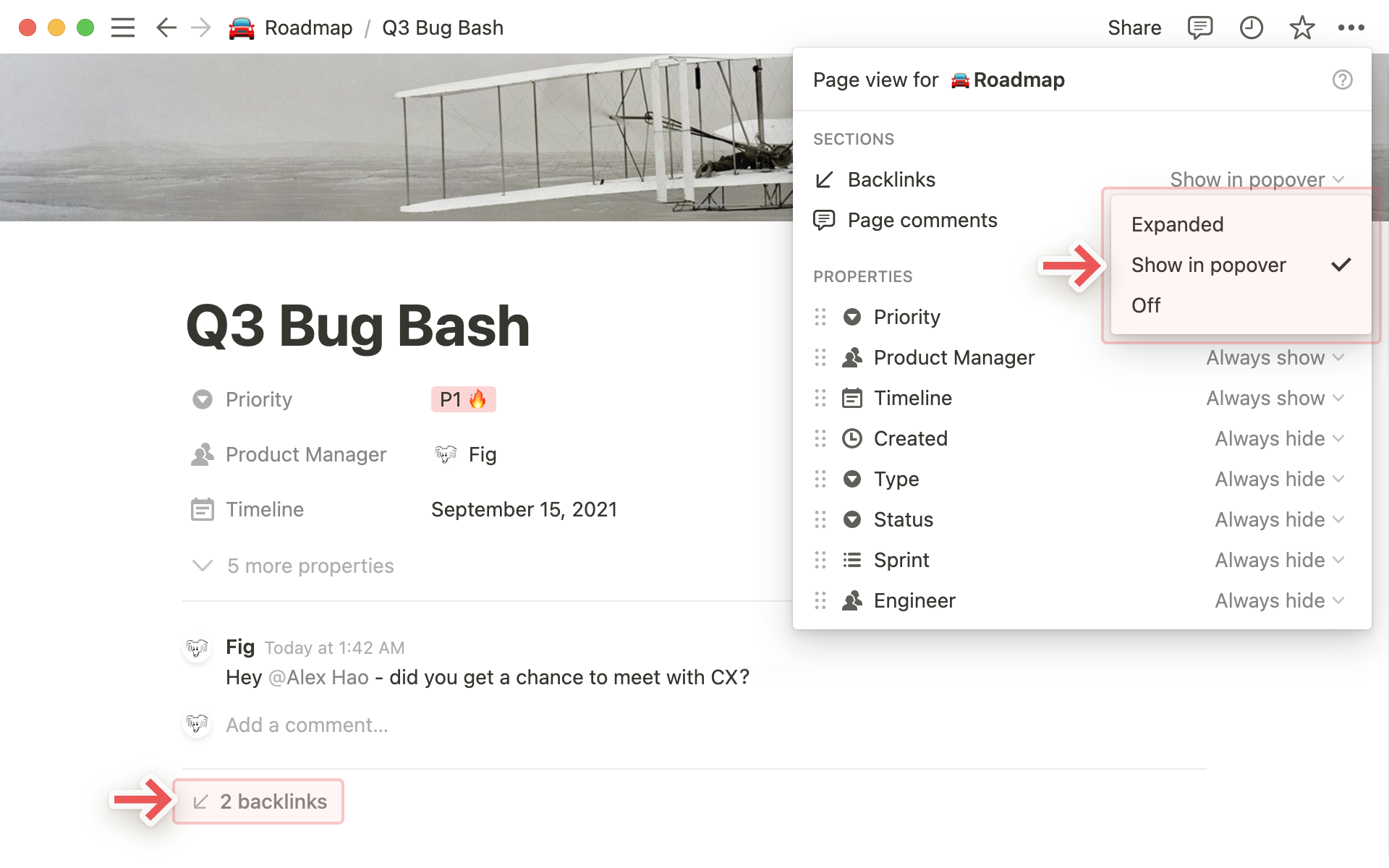
For comments, you can choose to show them:
Expanded: Show the full conversation at the top of the page.
Off: Hide comments on the page for a minimalist view.
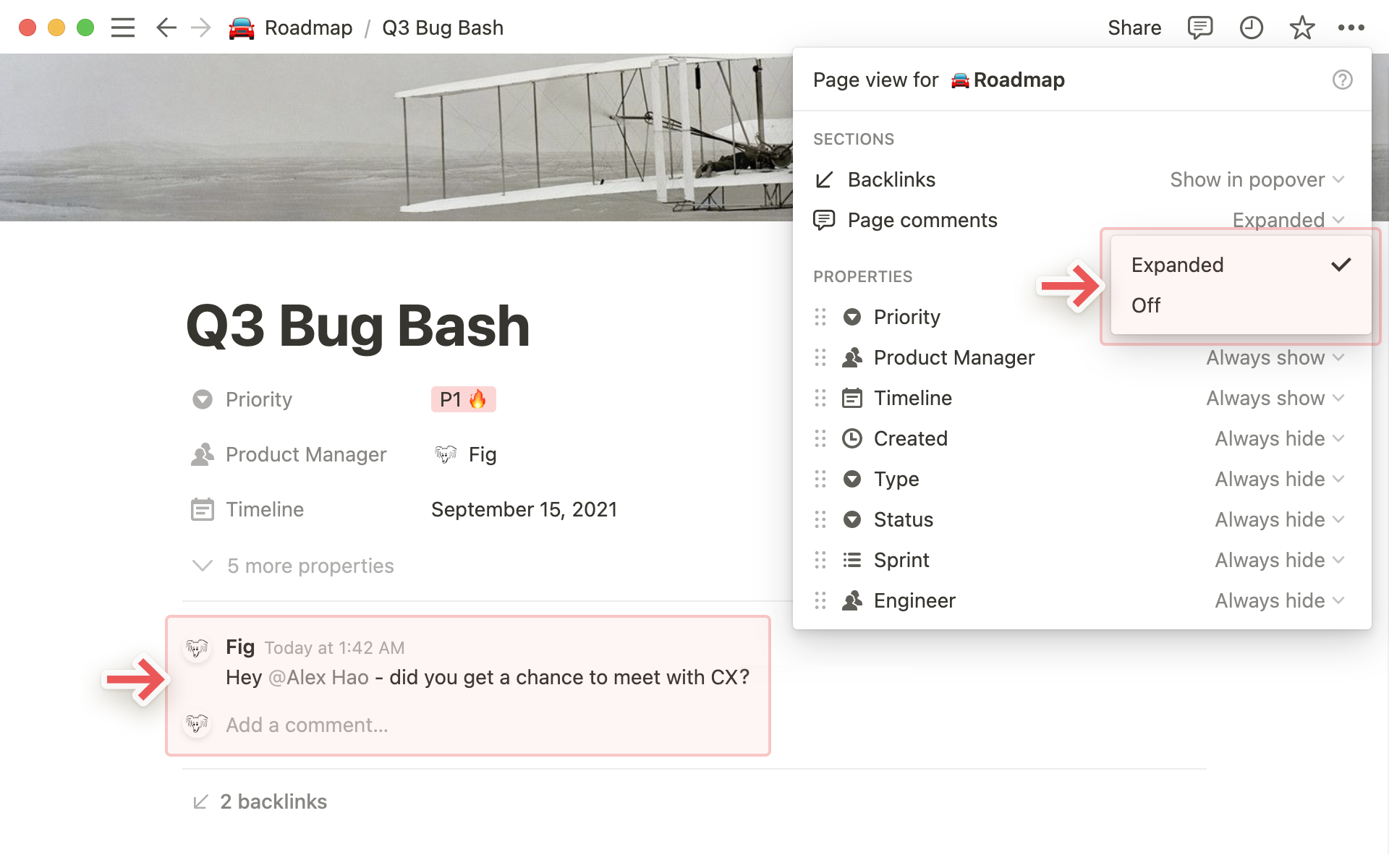
When using a database in a shared workspace, Notion has features in place to prevent accidental edits that could impact other teammates.
"Can edit content" permission level
Click Share at the top of a database to see and manage all users' permission levels. Learn more about sharing and permissions here →
The Can edit content permission level is only found on database pages, and allows users to:
Create, edit, and delete pages within the database.
Edit property values for those pages.
Users with Can edit content permissions in a database will not be able to:
Add, edit, or remove database properties or views.
Change filters or sorts.
Lock or unlock the database.
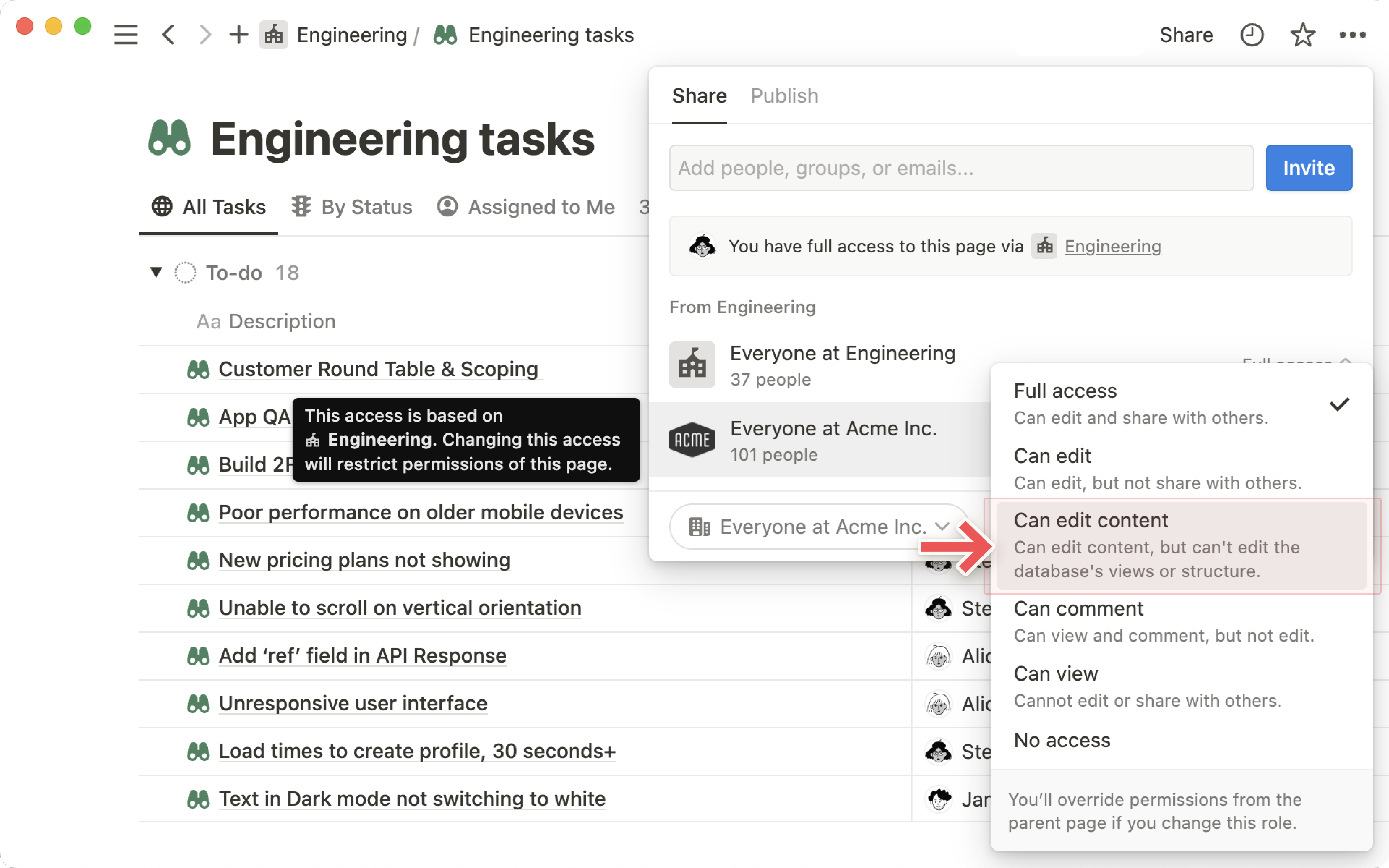
Note: Users with Can edit content access will still be able to create linked databases and edit views, sorts, and filters in that linked database. Learn more about linked databases →
Lock views
Find this option in the ••• menu at the very top right of the Notion window. Switch it on to prevent anyone from changing properties and views in your database. They'll still be able to edit the data it contains.
Note that anyone with editing access can toggle this lock on or off at any time. This is helpful as a quick safeguard against accidental edits in a database that you'd like many people to be able to change structurally.
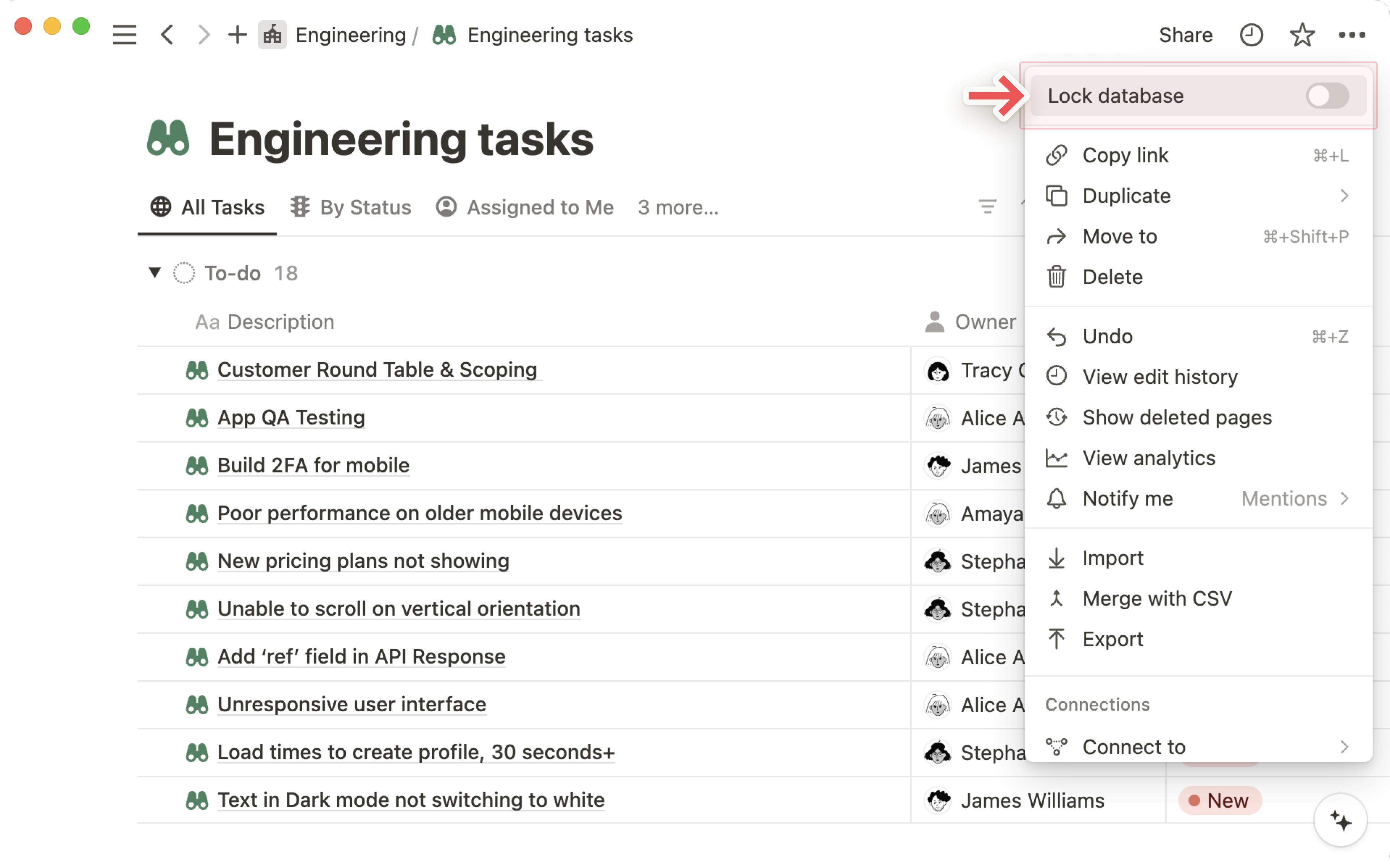
Learn more about how to optimize your databases' performance and load times here →
